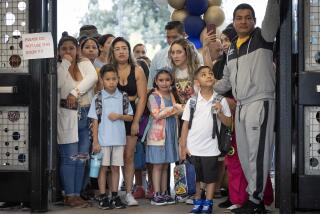Action-packed
- Share via
As the official start of summer approaches, parents around Southern California are bracing themselves for what will become the rallying cry of the season: “Mom, Dad, I’m boooooored!”
School vacation means the end of physical education class and recess for a few months -- and the beginning of parents fretting about how to trade the TV and computer for bike rides and baseball. Although camp or classes may provide children with some regular activity, not all families have access to those. Not to worry, though, say pediatricians -- with some planning, kids don’t have to be rooted to the sofa all summer long.
The essential component to keeping kids active is letting them choose what they want to do. “Sit down with your children and discuss some of the things they’d like to do this summer,” advises Dr. Mary L. Gavin, coauthor of “Fit Kids” (DK Publishing, 2004) and a pediatrician at the Alfred I. duPont Hospital for Children in Wilmington, Del. “Kids should be involved with this, because if they’re not on board, they’re not going to do it.”
Post a schedule of activities and make doing all of them a goal. “When kids say there’s nothing to do, parents can go to the list and say, ‘What haven’t you accomplished?’ ” she adds.
Parents can help brainstorm ideas, from in-line skating to going to a driving range, but they also need to set limits -- no weekly theme park outings, for instance.
And although top-of-the-line sports and fitness equipment isn’t a must, Gavin says it’s a good idea to stock a few inexpensive items, such as sidewalk chalk for hopscotch games, a hula hoop, or even a lawn sprinkler. Exercise videos for older teenagers are also good to have on hand.
The American Academy of Pediatrics recommends 20 to 30 minutes of aerobic activity three to four times a week, but it doesn’t always have to be structured or sports-related, such as soccer or basketball, says Dr. Angelee Reiner, a pediatrician at the UCLA Medical Center. Organized sports often finds kids sitting on the sidelines.
Playing dress-up or putting on a show, going to the beach, or walking around botanical gardens or the L.A. Zoo can keep kids moving for hours. Although Reiner acknowledges that child-oriented commercial gyms are well stocked and convenient, many parks have the same equipment and are free. “I think some parents think they have to have all this gear in the backyard,” she adds, “but I sometimes think it’s better for kids not to use a lot of that stuff because they don’t use their imaginations.”
With fresh fruits and vegetables in abundance, parents can also use the season to teach their children about good nutrition. “You might even get them involved in making a salad,” Gavin says. “Or you can go to a farmers market and learn about different things.” Planting a vegetable garden, she adds, is another way to encourage good eating habits and get kids moving.
Teenagers may be more inclined to play computer games or hang out with friends than younger kids are, but Gavin says moms and dads shouldn’t stop encouraging them to exercise. She suggests having them do active volunteer work or get a nonsedentary summer job. Teens can also accompany parents to the gym. She recommends parents write up an agreement stating how much activity is expected. “It sets some ground rules,” she says.
Older children involved in organized sports during the school year can keep that up via summer leagues or informal neighborhood teams, but competing shouldn’t be the goal, says Dr. Jordan Metzl, medical director of the Sports Medicine Institute for Young Athletes at the Hospital for Special Surgery in New York City.
“Make sure kids are having a good time,” he advises. “They can get burned out on sports if it’s too competitive. There’s this mentality to win at all costs.” Parents should also propose various athletic endeavors, even if the activities wouldn’t be their first choice. “Don’t show your bias against something,” he advises.
Karla Farrant has some activities scheduled for her 11- and 13-year-old daughters this summer, including a stint at surf camp, but this stay-at-home L.A. mother has a track record of keeping her kids busy.
“I can’t stand being idle,” says Farrant, an avowed gym aficionado. This summer the girls’ activities will include working on arts and crafts projects, swimming in public pools, hiking in Runyon Canyon, running track at the local park, going to museums and walking around Chinatown. “You don’t have to spend a lot of money,” Farrant says. “This is an interesting city.”
She says her daughters aren’t too tempted by television and computers, but some parents are constantly wresting their kids away from the screens.
Gavin suggests parents and kids agree on boundaries. “Tie it into being physically active,” she says. “If they’re outside playing for an hour, then they can spend an hour on the computer. When it comes to TV, let them pick the programs they want to watch, and when they’re over, the TV goes off.”
If parents work, weekends can be reserved for family outings such as bike rides or hiking, and parents and kids can take turns choosing an activity.
“If moms and dads like what they’re doing, that will encourage the kids,” Reiner says. “With all the stresses of life, families don’t spend a lot of time together, and going for a hike or even walking by the ocean is good for everyone. Parents become good role models, and kids grow up wanting to emulate that.”


